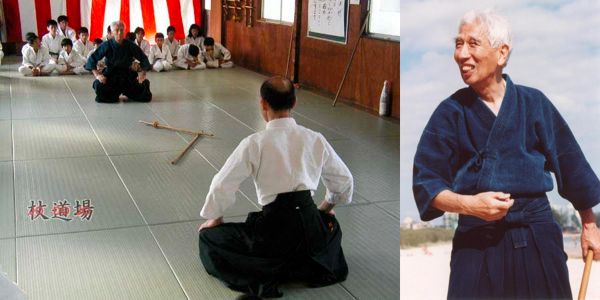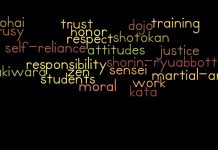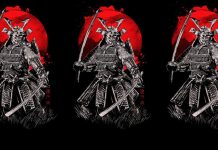 Q. Sensei, what do you believe are the crucial challenges facing Budo/Bujutsu in this century?
Q. Sensei, what do you believe are the crucial challenges facing Budo/Bujutsu in this century?
A. The standards of Bujutsu are slowly diminishing due to a lack of the appreciation of the aspect of Uchidachi (the receiver of the technique). UCHIDACHI MUST LEAD SHIDACHI. “The biggest problem in Budo today is that there are no highly trained Uchidachi. Good Uchidachi is essential to draw out the potential within Shidachi (the performer of the technique). The role of Uchidachi is to lead Shidachi. “Yes, that way so you can cut me this way! “Yes, this way”, Uchidachis’ role is critical. By practicing Kata, Uchidachi leads so as to be defeated. This is important. In Budo today, it often seems like there is no partner – even IAI is performed solo. This is not good. There should always be Uchidachi, and Shidachi must always think and research his role based on the impact of his actions upon Uchidachi.
Q. Why do you believe this insight is being lost?
A. There is a tendency to concentrate on merely winning with the introduction of competition, as opposed to the emphasis in practicing Kata. Matches (competitions) are held when yourself and your partner are at the same (equal) level. Then you can compete. But in that case, one may be encouraged to think that winning is most important and one may never reach the higher level of spirit. One should find that Kata practice is more important than competition. The person who performs better should be Uchidachi and, as Uchidachi, can then lead Shidachi. In that way improvement will be natural. (In SMR Jodo, all kihon are first learned unpartnered, then partnered. The 64 Kata which comprise the syllabus are all practiced partnered.) So, in true Keiko (practice), usually the teacher should be Uchidachi – the one willing to be hit and thrown by his student. Being Teacher is not an easy job. A good teacher will give advice to his students even while he’s being thrown and hit by the students. If you don’t want to have a partner, maybe you should start Zen. Zen doesn’t require a partner.
Q. In what ways can we return to this important understanding?
A. “What Budo needs is reason and all the reasons are found in Kata. We need to understand the purpose of Budo and the purpose of Kata. But these days, in many Budo, most people forget Kata. They might practice Kata a little and then only before grading tests.” He has difficulty in hiding his grief over this matter.
“Their excuse is that you can’t win the competition when you practice Kata”
Q. Sensei, has this type of change also occurred in the world of Kobudo?
A. Throughout the period before and after war and up to today, I have been watching and feeling with my own body, how Budo was forced to change its style and the relationship with the society from time to time.
“After the war, police stations decided to teach Jodo to policemen, so Shimizu-sensei and I traveled to many police stations around Japan to teach, but it was never taught as Budo, because around that time, Japanese Budo was still banned by the American Occupation Forces. Under the circumstances, Master Shimizu taught Jodo as “Pure way of using stick” demonstrating that policemen could use sticks to help them in their duty and service, but not as Budo. For example, it will make it easier if you use a long stick when you want to control a big crowd of people. Or even where there were huge traffic problems, if you use the long stick appropriately, traffic can be lead smoothly. So, even today, if you visit police stations, you will always see sticks there. The merit of the stick is that one can control the other without hurting him. The Jo does not cut like a sword, does not stab like spear, and also it does not give the others unnecessary fear or pressure even if you are holding it. With those merits, the Jo was accepted as a useful tool to keep safety and was formally adopted by the Japanese Police Force.
Q. Sensei, can you please share your ideas on the development of Budo?
Note: Nishioka Sensei has studied not only Jojutsu. From the age of 20, he has studied Kenjutsu (sword), achieving master Dan level.
A. “The Sword is the centre of Japanese Budo. All kinds of Japanese Budo have been developed from the view of how to compete against the sword. In other words, the technical styles of stick, spear, Japanese halberd etc.have been developed from the base of sword. When you talk about sword, the role of Uchidachi is the one to be focused upon. Also in Kenjutsu today, many masters do not take the role of Uchidachi. Instead they play the role of cutting their students.” Today Ken-do is practiced just for the competition, and Kata practice is treated lightly. This influence is coming now to Jodo and in this way modern Jodo is being lead astray.
Q. Sensei, how is this occurring?
A. Formally, Jodo is now practiced under the guidance of the All Japan Kendo League, so even though it uses a Jo, the core part of Jodo is adopting a similar format to Kendo. Shimizu Sensei originated today’s popular style of Jodo based on Shinto-Muso Ryu Jojutsu, so the basic spirit is supposed to be the same, but I do not see the same spirit in today’s Jodo. Perhaps most people wouldn’t know but people who have been practicing properly would definitely notice it.”
Q. Sensei, what do you mean when you say “properly”?
A. This again comes back to the key point about understanding the true roles of giving and receiving technique. The level of Budo practitioners will always drop if there is no teacher who knows the importance of Uchidachi, and can lead Shidachi so that Shidachi will learn with his body about timing and breath.”
Q. It seems there are many possible pitfalls when we start Budo training.
A. “This is true. When one starts practicing Jojutsu, one sometimes thinks ‘I can compete and win against the sword.’ No way. There are always those above us. Even when one makes huge progress, there is always higher level Uchidachi and it will never change as long as one practices Keiko. If we practice Keiko properly, we cannot help being humble all the time.”
Q. Sensei, from a technical point of view, what insights can you share with people seeking to develop their Budo practice?
A. In Japanese Bujutsu, when you match for life and death, the person who makes the first move will always lose. The technical reason is it becomes a battle of nerves and we need to know how to move the opponent first! This means to lead not just his body but his mind and spirit. Inviting the opponent, leading the opponent so he has to move, this kind of delicate technique is learnt only by practicing Kata with a true Uchidachi. Unfortunately much of todays’ Budo is just show and will not serve in life and death combat.
Secondly, in most Budo, and always in weapon based Budo, understanding the correct use of the inside of the hand (te no uchi) is essential. If you change inside of hand, your whole body approach also changes. This requires much training and cannot be explained easily in words.
Next is Hasuji (cutting line). Many Kenjutsu practioners emphasise the importance of Hasuji. Of course, if Hasuji is not straight, you cannot cut things. This can sometimes lead to a false idea of the true value of Bujutsu. It can be misunderstood through false practice to lie in being able to cut things. “Hasuji has to be straight and sharp, otherwise you can not cut the match. If Hasuji is not firm, it is no good. Left hand is the axis, and right hand is attached. Inside of the hands is very important. To check if Hasuji is straight and standing or not, you will never know unless you cut something like straw. Cutting the straw is for that purpose only. But today, it has become the performance of Budo. You cut the straw in front of people, and are applauded. This is merely a show. Cutting things is just Keiko, so you should not show it to people. It is different from the original style of how it was intended to be.
Q. Sensei, to draw out your wisdom accumulated over 64 years of training is difficult. Please tell us if there are important matters we have failed to discuss.
A. I have written several books on Bujutsu so of course to condense this into a short article is very difficult. There are several points however we can mention.
In all our Budo practice, we must begin with Rei and end with Rei. In English, Rei is most closely translated as etiquette. Seek to understand the purpose of Rei.
Study Kata. In Jodo all Kata is paired. Many people understand Kata and free training as separate and feel they must choose between them or allocate percentages to their practice. In fact they are part of a continuum and through Kata only can you truly be free.
Study Kihon (basics). Perhaps these should be renamed to explain their importance. They should be better called “Essence”.
Learn the meaning of “Shinken Shobu”. This is the matter of Life and Death.
Seek to understand “Keiko Shokon”. Searching for and mastering the essence is the training itself. If you think deeply about the essence of life, you must decide what to do now and actualize it.
Perhaps finally, is the formula for happiness. This is a simple matter. We have our desires and, when we achieve them, we have fulfillment. Usually our desires run far ahead of our achievement so we strive always against this trend to achieve fulfillment and happiness. Of course our potential and our desires are very different. We can reach up to our potential, but it is much more achievable to lower our desires than it is to always seek to fulfill them.
True happiness is then attainable.
Interview by David Dangerfield
Blitz Magazine, Volume 16, No 7





